

HomePod Mini vs. HomePod Buyer's Guide
source link: https://www.macrumors.com/guide/homepod-mini-vs-homepod/
Go to the source link to view the article. You can view the picture content, updated content and better typesetting reading experience. If the link is broken, please click the button below to view the snapshot at that time.

HomePod Mini vs. HomePod Buyer's Guide
In 2020, Apple unveiled the HomePod mini as the first addition to the popular HomePod lineup, with a new spherical design and the S5 chip. With a more affordable price tag of just $99, HomePod mini is a much more accessible and versatile HomePod in a compact design.
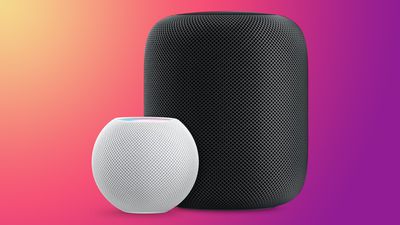
Comparing the HomePod and HomePod mini
The HomePod and HomePod mini share a number of key features, such as multiroom audio and Siri. Apple lists these same features of the HomePod and HomePod mini:
Similarities
- Multiroom audio
- Stereo pair capable
- Siri and upward-facing display
- Audio-conductive fabric
- Seamless audio handoff
- Smart home hub
- Intercom, Find My, Siri Shortcuts, Ambient sounds, Music alarms, Home Theater with Apple TV 4K, and Lossless audio
- Available in White and Space Gray
Apple's breakdown shows that the two HomePods share a number of important features. Even so, there are meaningful differences between the HomePod and HomePod mini which justifies the $200 price difference, including design, audio technologies, and spatial awareness.
Differences
Read on for a closer look at each of these aspects, and see what exactly both HomePods have to offer.
Design
At just 3.3-inches tall, the HomePod mini is much smaller than the original HomePod, which is just under seven inches tall. The HomePod mini also has a compact spherical design, while the original HomePod has a bulkier capsule-like design. The HomePod is larger than the HomePod mini to accommodate more internal components for a fuller audio experience.
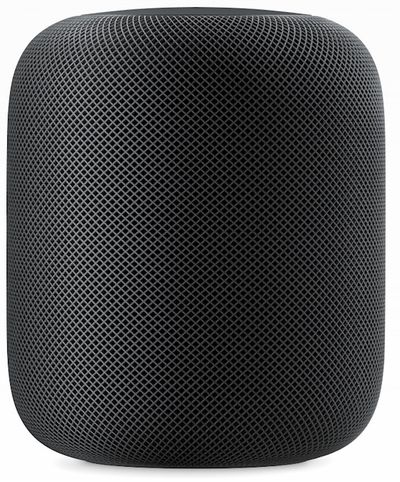
Both devices are covered in Apple's audio-conductive mesh material. The HomePod and HomePod mini also share the Siri waveform that appears on the top display to indicate when Siri is engaged, and integrated touch controls for volume. Both HomePods are also dependent on a wired power cable, meaning that neither is portable.
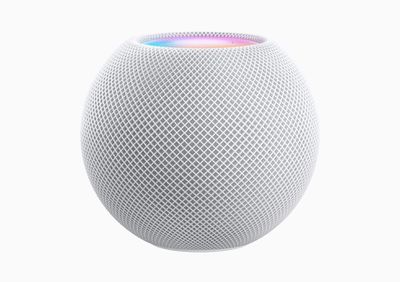
The HomePod mini's compact spherical design is more discreet than its larger sibling, and will be the preferred device for tables and surfaces where you have limited space or don't want it to stand out. Likewise, the larger HomePod will be more appropriate on TV units and areas with more space.
Audio Technology
Audio hardware is the most important area of difference between the two HomePods. HomePod mini offers a single full-range driver, powered by a neodymium magnet and a pair of force-canceling passive radiators, which enables deep bass and crisp high frequencies.
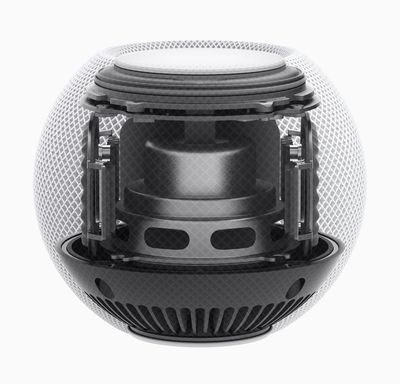
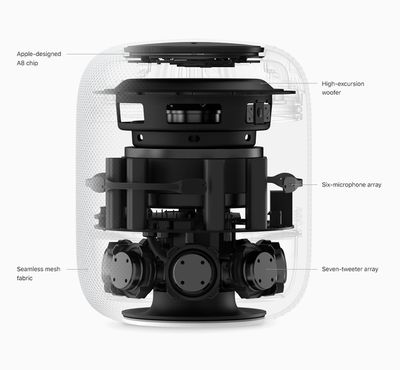
However, the original HomePod's larger size allows it to achieve a wider, more spacious soundstage. The HomePod will deliver richer, fuller sound compared to the HomePod mini. The HomePod mini will still delivers clean and functional sound, but there is no doubt that the added size and audio hardware in the larger HomePod overshadows it significantly.
Microphones
HomePod mini uses a three-microphone array to listen for "Hey Siri," and a fourth inward-facing microphone helps isolate sound coming from the speaker to improve voice detection when music is playing. The larger HomePod uses an array of six microphones for the same reason.
These microphones help to cancel echo and enable Siri to understand people whether they are near the device or standing across the room, even while loud music is playing. However, it is unclear if the added microphones on the HomePod are to counteract its louder, larger sound profile, while the HomePod mini simply doesn't need a six-microphone array due to its smaller size, or if it is a point of material difference between the two models when it comes to sound isolation.
Processor and Software
The HomePod uses the A8 chip from the iPhone 6, iPad mini 4, and Apple TV HD, while the HomePod mini uses the S5 chip from the Apple Watch Series 5 and Apple Watch SE.
The HomePod's processor allows it to use advanced software for real-time acoustic modeling, audio beam-forming, and echo cancellation.

HomePod mini uses its processor to maximize the performance of its less capable audio hardware. In an attempt to achieve big sound out of a compact design, the Apple S5 chip in HomePod mini works with advanced software to analyze the unique characteristics of the music and apply complex tuning models to optimize loudness, adjust the dynamic range, and control the movement of the driver and passive radiators in real-time.
The A8 chip in the larger HomePod likewise performs some unique functions, such as bass management through real-time software modeling that ensures the speaker delivers the deepest and cleanest bass possible, with low distortion.

Ultimately, the HomePod's processor is not a very important consideration when it comes to choosing between the two models. The A8 is an older but more powerful chip, while the S5 is a newer but less powerful chip. Both chips run the same operating system and deliver appropriate computational audio with a comparable level of performance.
Spatial Awareness
The larger original HomePod uses spatial awareness to sense its location in the room. This allows it to automatically adjust and optimize the audio based on its location in the room for improved sound quality. The HomePod can detect walls and corners, and uses this information with its directional tweeters to deliver sound evenly across the room, while reducing distortion and echo.
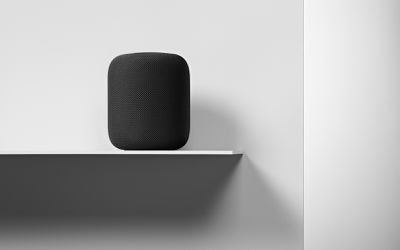
Only the original HomePod has spatial awareness, and the HomePod mini does not have this feature.
U1 Chip
The HomePod mini contains one feature that the original HomePod lacks: the U1 chip. The Apple-designed U1 chip is an ultra-wideband chip which performs directional and proximity-based operations.
The HomePod mini uses the U1 chip to detect when other U1 devices, such as the iPhone 12 or iPhone 13, are nearby. This allows it to more quickly hand off audio and interact with nearby devices, as well as display relevant information on devices that are close to the HomePod mini.
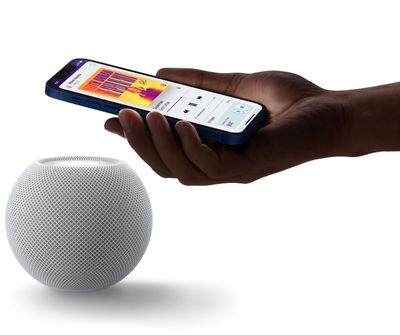
Beyond this, however, the full potential of U1 in HomePod mini does not yet seem to have been realized. In the future, U1 could facilitate close-range data-transfer, improve AR experiences, and track a user's location within the home. Apple now seems to be adding the U1 chip to all of its new devices, with the chip appearing in the iPhone 12 and iPhone 13 lineups, and the Apple Watch Series 6 and Series 7.
Stereo Sound
Adding a second HomePod to your setup enables stereo sound to create a wider soundstage for richer, more enveloping sound. Each HomePod is able to play its own channel of either left or right sound, while separating out both the ambient and direct energy. Both devices can perform automatic detection and balance of two speakers using both direct and reflected audio. Even though the two speakers act as one, each HomePod communicates with each other so that only one speaker responds to Siri requests.

While both HomePod and HomePod mini support this stereo pair capability, you cannot pair a HomePod mini and an original HomePod together. Instead, you can only pair two original HomePods or two HomePod minis as stereo speakers.
Both HomePods support multiroom audio and can be mixed together using that functionality, but not to achieve stereo sound.
Home Theater with Apple TV 4K
Both HomePods support Home Theater with Apple TV 4K. This allows the HomePod to provide a more immersive home theater experience when it is paired with an Apple TV 4K, by offering surround sound and Dolby Atmos.
The feature was initially only available with the original HomePod since it was reliant on the directional and spatially aware capabilities, but it has since expanded to the HomePod mini.
Spatial Audio
Only the original HomePod supports Spatial Audio with Dolby Atmos, a feature that was added via the iOS 15.1 software update in 2021.
Final Thoughts
Overall, it's clear that the HomePod and HomePod mini are products that have different purposes. The HomePod is a more full-featured high-end speaker for excellent sound quality, while the HomePod mini is intended to be more versatile.
This is reflected in the HomePod mini's more affordable price. The HomePod mini may be better suited to areas such as hallways or kitchens, while the original HomePod seems to be better suited to larger rooms where audio content is consumed more regularly, such as living rooms.
The main reason to buy the larger HomePod will be due to its better audio fidelity. As an extension of this, if you want to use your HomePods to enjoy Dolby Atmos audio, the larger HomePod is the only option to offer this. With its directional audio and spatial awareness, on top of its plethora of high-end audio hardware, the original HomePod is the device for areas where sound quality is the priority.
In locations where the device may be used more for Siri than music, HomePod mini seems to be the better option. The HomePod mini will be better when something more discreet is needed or if it is in an area where it would be used more in passing. The HomePod mini will still perform well in multiroom audio mode, and its more affordable price tag allows users to acquire more of them for use around the home.
Generally speaking, if you want a HomePod to achieve the best possible sound quality and volume, get the original HomePod. Otherwise, the HomePod mini will be more than sufficient for your needs.
Recommend
About Joyk
Aggregate valuable and interesting links.
Joyk means Joy of geeK